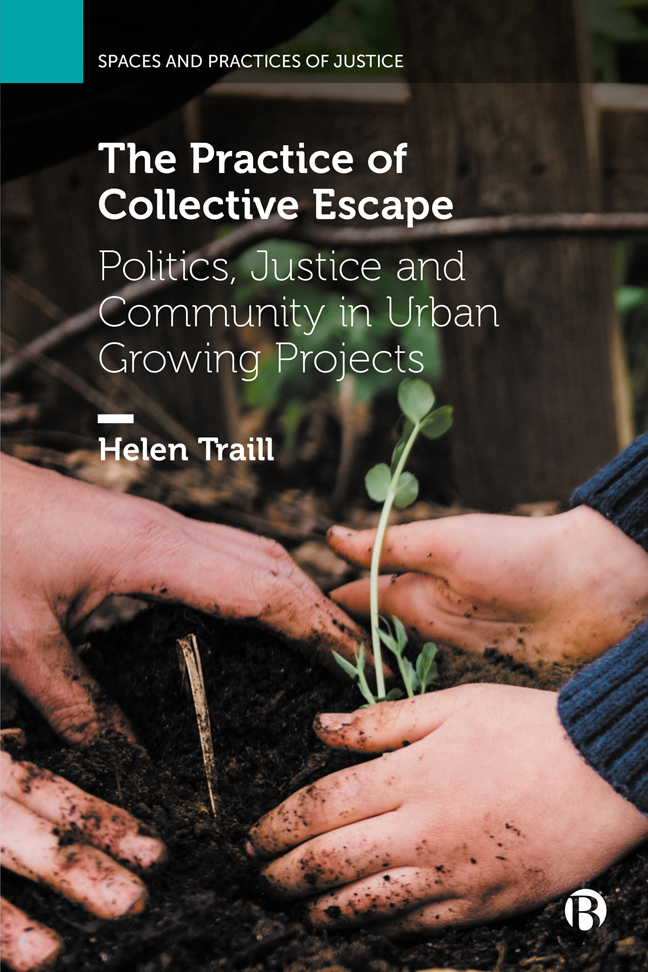Book contents
- Frontmatter
- Dedication
- Contents
- Series Preface
- Acknowledgements
- 1 Introduction
- 2 Urban Growing in Glasgow
- 3 The Rhythms of Urban Escape
- 4 Who Gets to Escape?
- 5 Ownership, Autonomy and the Commons
- 6 Escape into Responsibility
- 7 Field Dynamics and Strategic Neutrality
- 8 The Political Imagination of Common Justice
- 9 Escape, Crisis and Social Change
- 10 Conclusion
- Notes
- References
- Index
1 - Introduction
Published online by Cambridge University Press: 23 January 2024
- Frontmatter
- Dedication
- Contents
- Series Preface
- Acknowledgements
- 1 Introduction
- 2 Urban Growing in Glasgow
- 3 The Rhythms of Urban Escape
- 4 Who Gets to Escape?
- 5 Ownership, Autonomy and the Commons
- 6 Escape into Responsibility
- 7 Field Dynamics and Strategic Neutrality
- 8 The Political Imagination of Common Justice
- 9 Escape, Crisis and Social Change
- 10 Conclusion
- Notes
- References
- Index
Summary
A meadow in winter, a garden in spring
In the mornings, the North Kelvin Meadow is a calm place, periodically enlivened by dog walkers and people passing through as a shortcut to destinations both nearby and further afield in Glasgow. A mother and daughter pass through on the way to school, greeting the dogs. For them, passing through creates a break between the clamour to leave the house and the pressures of work and school. Others climb through the gaps in fences or walk between cheerfully painted bollards to sit among the trees reading a newspaper in a slither of sunlight coming through the branches of the birch trees. For some the meadow is a place to linger, to embrace the slowness of seasonality; or to speed up the boredom of having little to do. In the summer, the meadow's tree-lined edge blocks out the surrounding houses, lending the space a sense of disconnection from the rest of the city. In the middle of the meadow, it opens out: raised beds along one side and into the corner, open grass in the middle, worn through by use in places to its previous red, crumbling sports surface.
In my early research encounters with the meadow in December 2014, it was brittle with frost, the ground hard and the days short. Walking through with a local campaigner and long-time resident, Alasdair, who insisted that we leave the warmth of his flat where we were talking to take in the meadow around the corner in the early dusk of mid-winter, we spontaneously met others who wanted to talk about old shell casings found on the meadow, the history of the space. Alasdair was enthusiastic, garrulous even, in spite of the freezing temperatures. I had initially reached out to him to discuss the meadow's fight against the sale of the land for development but Alasdair insisted that to understand the space and its value, I had to appreciate its rich, common ordinariness in person and immediately. As he put it, “It's communal, everyone's entitled to use it.” In the meadow, the intertwined threads of mundane use and political campaigning against its development highlight critical tensions around who makes the city and how it might be remade and reimagined.
The meadow is embedded in the rhythms of everyday life for many local people; an everyday green space in the fabric of the city.
- Type
- Chapter
- Information
- The Practice of Collective EscapePolitics, Justice and Community in Urban Growing Projects, pp. 1 - 17Publisher: Bristol University PressPrint publication year: 2023

